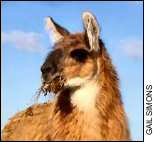| This is a slightly modified version of an article by Michael Trotter published in Rare Breeds NewZ for May 2006 |
Origins and Relationships
of the South American Camelids
If you want to get a detailed understanding of the origins and relationships of the South American camelids, you may find that it is not a particularly easy task, especially if you’re not altogether conversant with scientific terms such as mitochondrial, deoxyribonucleic acid, alleles and microsatellites.
 Vicuña |
Originally it was generally thought that the llama was descended from the wild guanaco and the alpaca from the wild vicuña. Then in the 1950s it became accepted that both were descended from guanacos, and this was reflected in their scientific names – Lama glama for llamas and Lama pacos for alpacas (the guanacos being Lama guanicoe). You’ll find a lot of sources – both printed and on the Internet – still saying that today.
 Alpaca |
However, in the 1990s, scientist Jane Wheeler postulated, mainly on the basis of their incisor teeth, that the progenitor of the alpaca was indeed the vicuña. Since then DNA studies by several researchers have shown close relationships between llama and guanaco on one hand, and between alpaca and vicuña on the other. This being the case, the scientific names currently in use are now: Lama glama for llamas, Lama guanicoe for guanacos; Vicugna pacos for alpacas, and Vicugna vicugna for vicuñas. (This, of course, begs the question of the relationship between the guanaco and the vicuņa, and DNA work shows them to have had a common ancestor some two to three million years ago.)
Although some authorities accepted that the vicuña was the progenitor of the alpaca at least as early as 1999, the definitive report on DNA research was published in the British Proceedings of the Royal Society in 2001.
 Llama |
An authoritative yet easily-read account of vicuña/alpaca relationship appeared in the Spring 2004 issue of the magazine Alpaca World under the title of “Alpaca DNA: From Wool to Genes (and Back Again!)” written by Professor Mike Bruford of Cardiff University. The author, who had worked closely with Jane Wheeler and other specialists, pointed out (as had Jane Wheeler) that more work needed to be undertaken before the genetic backgrounds could be fully understood, largely because of hybridisation between the main domesticated breeds.
In the meantime, though, we can accept that the major ancestor for the llama was the guanaco and the major ancestor for the alpaca was the vicuña.
Bruford, Mike, 2004. Alpaca DNA: From Wool to Genes (and Back Again!). Alpaca World Summer 2004.
Clutton-Brock, Juliet, 1999. A Natural History of Domesticated Mammals, Cambridge University Press, Cambridge. Page 158.
Kadwell, M., Fernandez, M., Stanley, H.F., Baldi, R, Wheeler, J.C., Rosadio, R, and Bruford, M.W., 2001. Genetic analysis reveals the wild ancestors of the llama and the alpaca. Proceedings of the Royal Society B: Biological Sciences, Volume 268, Number 1485, pages: 2575-2584.
Wheeler, Jane, 1998. Evolution and Origin of the Domestic Camelids. The Alpaca Registry Winter-Spring 1998. [Modified versions of this article have been published in the ILR (International Lama Registry) Report Vol.8, Issue 2, Summer 2003, and elsewhere.]